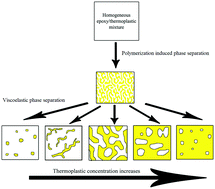An overview of viscoelastic phase separation in epoxy based blends
Abstract
The viscoelastic effects during reaction induced phase separation play an important role in toughening epoxy-based blends. The large difference in molecular weight/glass transition temperature between the blend components before the curing reaction results in dynamic asymmetry, causing viscoelastic effects during phase separation accompanying the curing reaction. This review will focus on the key factors responsible for viscoelastic phase separation in epoxy-based blends and hybrid nanocomposites. Time-resolved characterization techniques such as rheometry, small angle laser light scattering, optical microscopy etc., are mainly used for monitoring the viscoelastic effects during phase separation. Incorporation of nanofillers in epoxy thermoplastic blends enhances the viscoelastic phase separation due to the increase in dynamic asymmetry. Different theoretical models are identified for the determination of processing parameters such as temperature, viscosity, phase domain size, and other parameters during the viscoelastic phase separation process. The effect of viscoelastic phase separation has a very strong influence on the domain parameters of the blends and thereby on the ultimate properties and applications.



 Please wait while we load your content...
Please wait while we load your content...